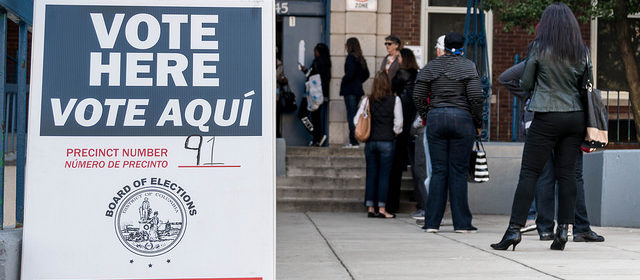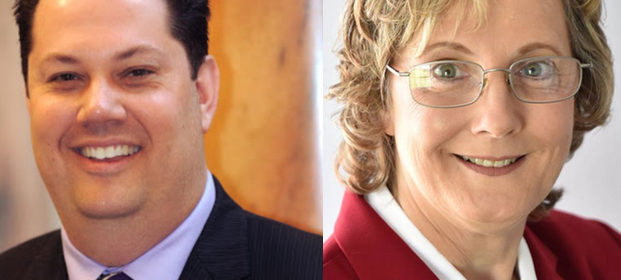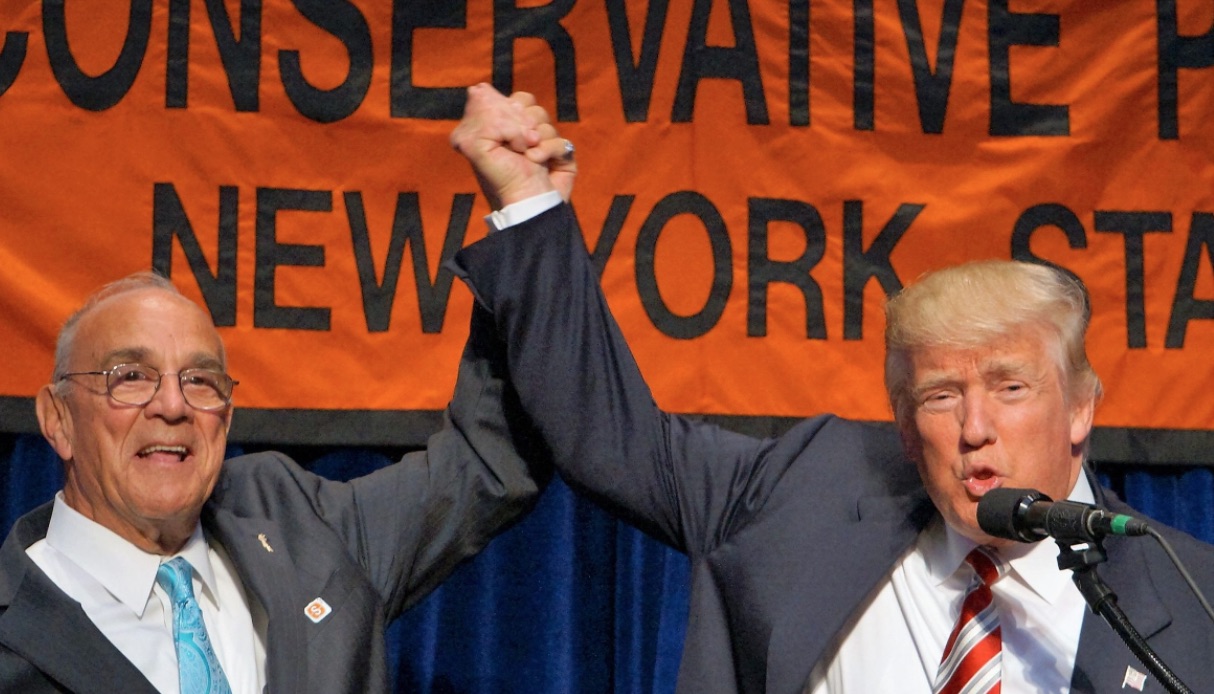If you ever wanted to know how political staffers get their jobs, it’s by doing a lot of boring, annoying, time-consuming grunt work that no one else wants to do. They have to be loyal and trustworthy, and they have to be able to accomplish with a straight face the tasks required of their job.
That’s not rocket science, that’s not automatically “bad”, it’s how it’s been done since time immemorial, everywhere, and isn’t going to change anytime soon.
But New York State is unique the way in which it permits its politics to be manipulated, and it’s unique in how corrupt and pervasive it’s become. We are one of a very small handful of states that permit electoral fusion, which enables minor parties to endorse candidates who aren’t party members. We have a “Conservative Party” that has a conservative platform to which it adheres when convenient, and we have the Tom Golisano-founded “Independence Party”, which is never independent and exists largely to confuse people who want to register as small-i independents, and don’t realize that New York calls them “unenrolled”. We also have the Working Families Party, which is very tight with both public and private sector unions, and is candid about its activist role. Only the Green Party eschews the fusion game.
I have written about fusion for many years, and advocated for its abolition. It most recently came up during the State Senate’s debate of the same sex marriage law, when Conservative Party “leaders” were openly threatening Senator Mark Grisanti not to vote in favor of it. It’s notable that this horrible “party” is now endorsing anti-same-sex-marriage, nominal Democrat and former County Legislator Chuck Swanick to run against Grisanti.
After the County budget crisis of the last decade, I thought it’d be impossible for Swanick to ever dare to re-gain elected office again. Or any job that didn’t end with the suffix “the clown”. At the time, Swanick had switched to the Republican Party in order to be elected legislature chairman, and even after that, he was at the forefront of a fiscal disaster, and had a hand in assisting Butch Holt to give a county contract to his brother’s Texas-based basketball camp, and a $3 million no-bid contract to a glorified answering service called “community corrections” – a huge attempted scam.
The Republican primary race in the newly constructed NY-27 district has revealed some dramatic cleaves in the WNY Republican firmament. You have rich, country-club Republican against middle-class, war vet Republican. You have suburban vs. rural. You have conservative vs. crony capitalism. Above all, you have the story of David Bellavia and the Erie County GOP. In 2008, Bellavia agreed to step aside in favor of Chris Lee in the NY-26 race in a deal struck with current ECGOP chairman Nick Langworthy. The deal was, Bellavia lets Lee have the seat, and when Lee vacates the seat, it would be Bellavia’s turn.
But it didn’t turn out that way, and Bellavia was not just snubbed in 2010 when Lee resigned in a Craigslist sex scandal – he was cajoled and threatened. In early 2011, Bellavia was cornered in a back room of an Elmwood Avenue cafe by Chris Collins, Carl Paladino, and Paladino’s lieutenant, Rus Thompson. The trio played good cop/bad cop, attempting to clear the way for Collins’ neighbor, Assemblywoman Jane Corwin, to get the NY-26 nod. They alternately threatened to reveal embarrassing information about Bellavia’s finances, then offering him an endorsement for an Assembly seat of his own. Corwin went on to lose dramatically to Kathy Hochul in what turned out to be almost a frame-by-frame foreshadowing of the November 2011 County Executive race. 
To this day, the Erie County Republican Committee has refused to endorse Bellavia for any office, and has reneged completely on the deal it made to clear Chris Lee’s way to Washington.
With redistricting, the lines have changed and Corwin isn’t trying again. Instead, in keeping with the apparent ECGOP policy that a chief qualification for Congress is that you reside on Cobblestone Drive in Clarence, the recently defeated hobbyist-politician Chris Collins has stepped out to yet again deny Bellavia a shot at a congressional race. Bellavia, however, is not bowing out. He has garnered the support of the xenophobic-but-wealthy Jack Davis, and the endorsement of the Republican committees of every one of the so-called “GLOW” (Genesee, Livingston, Orleans, Wyoming) counties. Bellavia’s campaign has been assisted by former Paladino campaign manager Michael Caputo, and while his fundraising gap vs. Collins is wide, so is the enthusiasm gap – Collins hasn’t made many friends, and is finding that he’s a tough sell outside of Erie and Niagara Counties, within the Buffalo media market that treated him with kid gloves.
There is some overlap between NY-27 and the State Senate district occupied by Michael Ranzenhofer. Although Ranzenhofer claims to be neutral in the Collins – Bellavia battle, he is a product of the Erie County Republican machine, and close friends with Collins ally and Washington strategist Michael Hook. A few weeks ago, one of Ranzenhofer’s Wyoming County-based staffers, Michelle McCullough, was named to Bellavia’s campaign’s steering committee. After all, she is a Wyoming County committeewoman and at worst, she was going along with her committee’s endorsement. She was quickly fired. The Batavian has a story that confirms the political rationale and scheming that led to McCullough’s termination. Text messages confirm that Erie County GOP Chairman Nick Langworthy criticized McCullough for her endorsement of Bellavia, and one of her colleagues warned her that “Hook called Ranz” just days before her termination.
Ranzenhofer continues to insist that he is neutral in the NY-27 primary race.
Yet that doesn’t explain another point that the Batavian revealed. In New York, one of the easiest ways you can circulate nominating petitions for a political party with which you’re not registered is to become a Notary Public. The Batavian story reveals that at least six of Ranzenhofer’s staffers are licensed notaries, and not coincidentally went out and collected petition signatures for Chris Collins for the Conservative Party line; everybody including Michelle McCullough, the staffer fired for her support of David Bellavia. All of the signatures were collected in eastern Erie County, following an instruction to ignore GLOW counties.
In addition to the apparent lack of supposed neutrality in the Ranzenhofer office regarding the NY-27 race, sources confirm that Erie County Republican elections commissioner Ralph Mohr delivered the Conservative Party petitions to the Ranzenhofer staffers. They didn’t collect signatures on state time, but were asked to use their own “comp” time to do so – time that was theirs and that they had earned as time off.
It shows that the Erie County Republican Committee is not just not neutral in this race, but that it is actively assisting Chris Collins’ effort, and working in concert – in effect controlling – the concomitant effort to get Collins on the Conservative Party ballot.
This is nothing new, and it’s not unique to the Republican or Conservative Parties. The Erie County Independence Party has lost its right and ability to endorse candidates to the state party apparatus. This is because ECDC Chairman Len Lenihan had in 2006 attempted an outright takeover of the IP by urging Democrats to become active IP members. This resulted in the local committee endorsing one candidate, and the state committee endorsing another – a conflict that was resolved in the state’s favor through recent litigation. State committee chair Frank MacKay has taken to endorsing Republicans in recent local races.
You’ll note that not one piece of information written above has anything whatsoever to do with good policy, platform positions, or anything else commonly associated with what government and politics are supposed to be about. This is all about influence and power, and in the case of the minor fusion parties, their sole mission in life is to offer and execute Wilson Pakulas in exchange for influence, power, and – above all – jobs.
One of the oldest and most-repeated excuses for why we allow fusion voting in New York has to do with the mythological straight-line voter. Presumably, such a voter who is, e.g., a registered and loyal Democrat would never, ever color in a Republican ballot oval, even if the choice was for an objectively superior candidate. (Think Antoine Thompson vs. Mark Grisanti). So, the minor party lines give that type of voter the cover to vote for the right person and not fill in the “R” line.
I’m sure these people exist, but I’m not convinced that the existence of the “C” and “I” or “WFP” lines somehow magically give them the moral cover to do something they’d otherwise never do. I’d love to see some polling on that; I think it’s utter speculation and, if it exists, affects a very small number of voters.
It wasn’t too long ago that the Erie County Independence Party was run by a Springville-based barber who was quite brazenly transactional. The current Erie County Conservative Party leader is well-regarded in political circles, and enjoys wide, multi-partisan friendship and support due to his friendly weekend kaffeeklatsches at Daisie’s in Lackawanna. But during at least one local supervisor’s race last year, it was revealed that the Conservative Party endorsement could be inextricably linked with Mr. Lorigo’s own business interests, as it was alleged that he had withheld an endorsement on pretextual moral grounds, but in reality because the town board had voted against a zoning change that would have directly benefited Lorigo’s business interests, and he was punishing the sitting supervisor for not asserting more influence over the process.
State Conservative Party chair Mike Long and Ralph Lorigo are persuasive when they threaten Mark Grisanti, who defeated Antoine Thompson by only about 500 votes, and 4,300 of his votes came on the Conservative line. It comes down not to doing the right thing, but counting votes. But really, the Conservative Party has no business wielding the political power it does. In 2010, about 4.6 million New Yorkers voted – only about 232,000 of them on the Conservative line; that’s 5% of people who cast ballots. The enrollment in Erie County breaks down this way: Democrats: 286,112; Republicans: 153,179; Conservative Party; 11,811; Independence Party: 24,962; Working Families Party: 2,665; Green Party: 1,225; Libertarian Party: 242; unenrolled: 90,908. So, we have 571,104 registered Erie County voters, only 2% of whom are members of the Conservative Party, and only 4% of whom are registered as “Independent”. Yet these two little nothing parties with a negligible number of members have practical control over who gets elected.
The minor parties’ political influence exponentially outweighs their membership or ballot results. I’m tired of progress and legislation being held up by little men with little minds whose political parties are only mildly more legitimate and popular than the “Rent is Too Damn High” Party. Why was Tony Orsini taken seriously as a political player? Who is Ralph Lorigo to demand fealty from candidates? How did a panoply of Independence Party hacks get jobs at the Erie County Legislature in 2010? Are Lorigo’s decisions on endorsements based on Conservative Party principles, or on unprincipled self-interest?
To put it bluntly, electoral fusion is one of the chief reasons why we in western New York can’t have nice things. It ensures that our politics are uniquely and overwhelmingly transactional, to the benefit of the connected and the detriment of the average citizen. Somewhat ironically, fusion is the reason why fusion won’t be abolished anytime soon. Too many pols have too intense a reliance on a process that theoretically relies on inflexible low-information voters to succeed. The elected who campaigns too strenuously to unsuccessfully end fusion will find himself returned to the dreaded private sector, with its crappy health insurance and absence of fat, tax-free pensions.
End electoral fusion, and New York will have enacted a very significant reform that will, in turn, help to hasten other policies and reforms that will help move the state forward. Next time you ask why any local pol chooses not to show leadership on some matter of controversy, refer back to transactional politics and fusion.






 It’s petition day throughout New York State, and we’ll learn soon enough that
It’s petition day throughout New York State, and we’ll learn soon enough that  You want to be angry about Cuomo dismantling the Moreland Commission on public corruption literally overnight to cut a budget deal?
You want to be angry about Cuomo dismantling the Moreland Commission on public corruption literally overnight to cut a budget deal? 